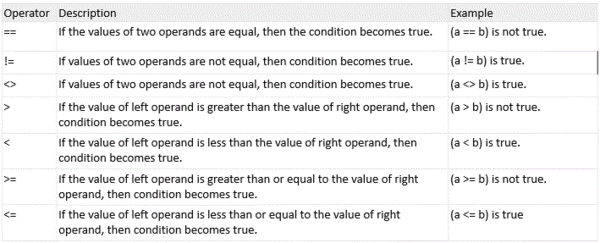Difference between revisions of "Selection - Python"
| Line 33: | Line 33: | ||
#Create a variable called answer & set it to a number. Ask the user to enter a guess and then check against the answer. | #Create a variable called answer & set it to a number. Ask the user to enter a guess and then check against the answer. | ||
| − | =Logical Operators= | + | ==Logical Operators== |
If we want something to be False we can use not. It is a logical operator: | If we want something to be False we can use not. It is a logical operator: | ||
| Line 55: | Line 55: | ||
if 1 > 2 and 4 < 10: | if 1 > 2 and 4 < 10: | ||
print("condition not met") | print("condition not met") | ||
| − | + | ||
===Or=== | ===Or=== | ||
| Line 65: | Line 65: | ||
You are not restricted to one logical operator. You can combine as may as you want. | You are not restricted to one logical operator. You can combine as may as you want. | ||
| + | |||
| + | =Else If (elif)= | ||
| + | In python the Else If is combined to be called elif. This can follow an if or another elif. So the if would check to see if something is true, the elif will check another condition with the values which failed the original if. For example: | ||
| + | |||
| + | <syntaxhighlight lang=python> | ||
| + | mark = input("Please enter your mark") | ||
| + | if mark > 90: | ||
| + | print("A*") | ||
| + | elif mark > 80: | ||
| + | print("A") | ||
| + | elif mark > 70: | ||
| + | print("B") | ||
| + | elif mark > 60: | ||
| + | print("C") | ||
| + | elif mark > 50: | ||
| + | print("D") | ||
| + | elif mark > 40: | ||
| + | print("E") | ||
| + | else: | ||
| + | print("U") | ||
| + | <syntaxhighlight lang=python> | ||
Revision as of 12:53, 20 June 2018
Contents
What is Selection
Selection is a key construct that exists in any programming language, and each language has a specific implementation but they are all relatively the same.The other key constructions are sequence (ie program runs in order) and iteration (loops).
If Statement in Python
Use the command ‘if’ followed by a condition & the colon ‘:’, The condition should equate to true or false. Instead of using brackets, in python you indent the code to run if true. Each line with the same indent will be run if true. The else can also be used followed by a colon ‘:’ and again the code to run in the else should be indented:
if true:
line 1
line 2
else:
line 3
line 4
Comparison Operators
The condition in the if statement must equate to true or false, so comparison operators are required. In python the comparison operators are:
Example
The if...else statement can be used to make a decision:
age = input("Please enter your age:")
if age>=18 :
print("You are old enough to drink")
else :
print("you are not old enough to drink")
Now Try
- Create the code to check if a person should receive the national living wage (25)
- Create a variable called answer & set it to a number. Ask the user to enter a guess and then check against the answer.
Logical Operators
If we want something to be False we can use not. It is a logical operator:
Not
x = False
if not x :
print("condition met")
else:
print("condition not met")
Two easy to understand operators are and and or. They do exactly what they sound like::
And
<syntaxhighlight lang=python> if 1 < 2 and 4 > 2:
print("condition met")
if 1 > 2 and 4 < 10:
print("condition not met")
Or
<syntaxhighlight lang=python> if 4 < 10 or 1 < 2:
print("condition met")
<syntaxhighlight lang=python>
You are not restricted to one logical operator. You can combine as may as you want.
Else If (elif)
In python the Else If is combined to be called elif. This can follow an if or another elif. So the if would check to see if something is true, the elif will check another condition with the values which failed the original if. For example:
<syntaxhighlight lang=python> mark = input("Please enter your mark") if mark > 90:
print("A*")
elif mark > 80:
print("A")
elif mark > 70:
print("B")
elif mark > 60:
print("C")
elif mark > 50:
print("D")
elif mark > 40:
print("E")
else:
print("U")
<syntaxhighlight lang=python>
